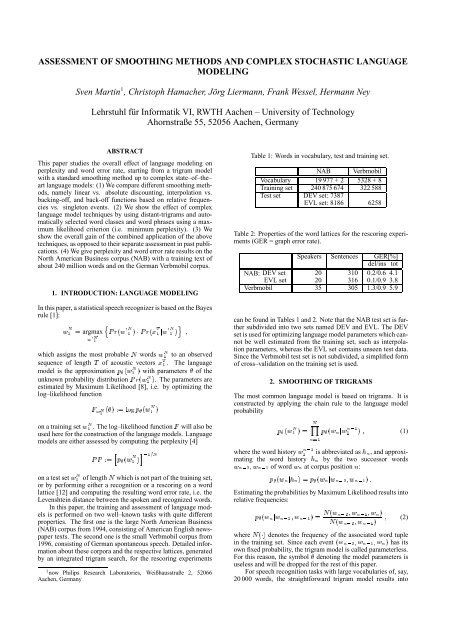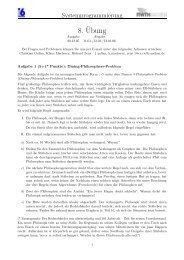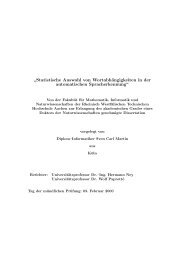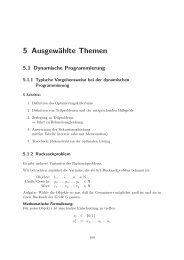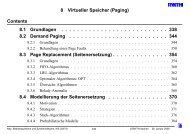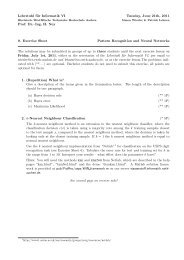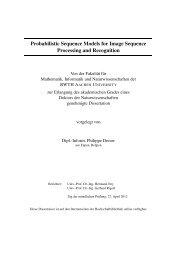n o h Y - Www I6 Informatik Rwth Aachen - RWTH Aachen University
n o h Y - Www I6 Informatik Rwth Aachen - RWTH Aachen University
n o h Y - Www I6 Informatik Rwth Aachen - RWTH Aachen University
You also want an ePaper? Increase the reach of your titles
YUMPU automatically turns print PDFs into web optimized ePapers that Google loves.
ASSESSMENT OF SMOOTHING METHODS AND COMPLEX STOCHASTIC LANGUAGE<br />
MODELING<br />
Sven Martin1, Christoph Hamacher, Jörg Liermann, Frank Wessel, Hermann Ney<br />
Lehrstuhl für <strong>Informatik</strong> VI, <strong>RWTH</strong> <strong>Aachen</strong> – <strong>University</strong> of Technology<br />
Ahornstraße 55, 52056 <strong>Aachen</strong>, Germany<br />
ABSTRACT<br />
This paper studies the overall effect of language modeling on<br />
perplexity and word error rate, starting from a trigram model<br />
with a standard smoothing method up to complex state–of–the–<br />
art language models: (1) We compare different smoothing methods,<br />
namely linear vs. absolute discounting, interpolation vs.<br />
backing-off, and back-off functions based on relative frequencies<br />
vs. singleton events. (2) We show the effect of complex<br />
language model techniques by using distant-trigrams and automatically<br />
selected word classes and word phrases using a maximum<br />
likelihood criterion (i.e. minimum perplexity). (3) We<br />
show the overall gain of the combined application of the above<br />
techniques, as opposed to their separate assessment in past publications.<br />
(4) We give perplexity and word error rate results on the<br />
North American Business corpus (NAB) with a training text of<br />
about 240 million words and on the German Verbmobil corpus.<br />
w0N1nPr(w0N1)Pr(xT1jw0N1)o;<br />
1. INTRODUCTION: LANGUAGE MODELING<br />
In this paper, a statistical speech recognizer is based on the Bayes<br />
rule [1]:wN1=argmax<br />
FwN1():=logp(wN1)<br />
which assigns the most probableNwordswN1to an observed<br />
sequence of lengthTof acoustic vectorsxT1. The language<br />
model is the approximationp(wN1)with parameters of the<br />
unknown probability distributionPr(wN1). The parameters are<br />
estimated by Maximum Likelihood [8], i.e. by optimizing the<br />
log–likelihood function<br />
PP:=hp(wN1)i1=N<br />
on a training setwN1. The log–likelihood functionFwill also be<br />
used here for the construction of the language models. Language<br />
models are either assessed by computing the perplexity [4]<br />
on a test setwN1of lengthNwhich is not part of the training set,<br />
or by performing either a recognition or a rescoring on a word<br />
lattice [12] and computing the resulting word error rate, i.e. the<br />
Levenshtein distance between the spoken and recognized words.<br />
In this paper, the training and assessment of language models<br />
is performed on two well–known tasks with quite different<br />
properties. The first one is the large North American Business<br />
(NAB) corpus from 1994, consisting of American English newspaper<br />
texts. The second one is the small Verbmobil corpus from<br />
1996, consisting of German spontaneous speech. Detailed information<br />
about these corpora and the respective lattices, generated<br />
by an integrated trigram search, for the rescoring experiments<br />
1 now Philips Research Laboratories, Weißhausstraße 2, 52066<br />
<strong>Aachen</strong>, Germany<br />
Table 1: Words in vocabulary, test and training set.<br />
NAB Verbmobil<br />
Vocabulary 19 977 + 2 5328 + 8<br />
Training set 240 875 674 322 588<br />
Test set DEV set: 7387<br />
EVL set: 8186 6258<br />
Table 2: Properties of the word lattices for the rescoring experiments<br />
(GER = graph error rate).<br />
Speakers Sentences GER[%]<br />
del/ins tot<br />
NAB: DEV set 20 310 0.2/0.6 4.1<br />
EVL set 20 316 0.1/0.9 3.8<br />
Verbmobil 35 305 1.3/0.9 5.9<br />
can be found in Tables 1 and 2. Note that the NAB test set is further<br />
subdivided into two sets named DEV and EVL. The DEV<br />
set is used for optimizing language model parameters which cannot<br />
be well estimated from the training set, such as interpolation<br />
parameters, whereas the EVL set contains unseen test data.<br />
Since the Verbmobil test set is not subdivided, a simplified form<br />
of cross–validation<br />
p(wN1)=NYn=1p(wnjwn1<br />
on the training set is used.<br />
1);<br />
2. SMOOTHING OF TRIGRAMS<br />
The most common language model is based on trigrams. It is<br />
constructed by applying the chain rule to the language model<br />
probability<br />
p(wnjhn)=p(wnjwn2;wn1):<br />
(1)<br />
where the word historywn1<br />
p(wnjwn2;wn1)=N(wn2;wn1;wn)<br />
1is abbreviated ashn, and approxi-<br />
N(wn2;wn1);<br />
mating the word historyhnby the two successor words wn2;wn1of wordwnat corpus positionn:<br />
Estimating the probabilities by Maximum Likelihood results into<br />
relative frequencies:<br />
(2)<br />
whereN()denotes the frequency of the associated word tuple<br />
in the training set. Since each event(wn2;wn1;wn)has its<br />
own fixed probability, the trigram model is called parameterless.<br />
For this reason, the symbol denoting the model parameters is<br />
useless and will be dropped for the rest of this paper.<br />
For speech recognition tasks with large vocabularies of, say,<br />
20 000 words, the straightforward trigram model results into
81012trigrams, each of them with its own probability. This<br />
large number cannot be estimated from today’s training sets of<br />
up to one billion words. Thus, most probabilities will be estimated<br />
by Eq. (2) as zero, which is not desired and, by the chain<br />
rule Eq. (1), estimates the whole test set as zero if such a trigram<br />
appears in it. This is known as the sparse data or zero frequency<br />
problem.<br />
To counteract this problem, smoothing methods are applied.<br />
With smoothing,<br />
p(wjh)=(1)N(h;w)<br />
probability mass is discounted from the trigrams<br />
observed in the training set<br />
N(h)+ (wjh)<br />
and redistributed over the remaining<br />
(unseen) trigrams according to a more robust probability<br />
distribution(wjh)based on a simplified word historyh. In<br />
case of the trigram model, the bigram probability distribution is<br />
used as(wjh). A simple smoothing method is linear discounting [4] with<br />
the<br />
p(wjh)=8>:(1)N(h;w) N(h);<br />
two variants interpolation<br />
(wjh)<br />
or backing–off: N(h;w)>0,<br />
p(wjh)=max0;N(h;w)d<br />
Pw0:N(h;w0)=0(w0jh);otherwise<br />
N(h) +dn+(h) N(h) (wjh)<br />
Since the most reliably estimated (i.e. the most frequent) events (h;w)are distracted most by using linear discounting, an alternative<br />
called absolute discounting was proposed in [10] and<br />
tested in [11]. Using interpolation, this approach results in:<br />
withn+(h)as the number distinct events(h;w)observed in<br />
the training set. Absolute discounting can also be used with<br />
backing–off.<br />
Both the interpolation parameter and the discounting value<br />
dwould be estimated as zero on the training set because, by definition,<br />
the are no unobserved events in the training set. A method<br />
called leaving–one–out, a special case of cross–validation, is<br />
used for that task [10]: each position in the training set is visited,<br />
the event at that position dropped and the probability for that<br />
event estimated on the remainingN1events. Thus, events observed<br />
once in the training set (singletons) become unobserved.<br />
Closed–form solutions exist for both andd. It is even possible<br />
to derive a bigram statistics based on singleton events for<br />
the probability distribution(wjh)[7], called singleton back–<br />
off (BO) function.<br />
Tables 3 and 4 show the effect of the presented smoothing<br />
methods on the NAB and Verbmobil corpora, respectively. Interpolation<br />
is superior to backing–off in most cases, absolute to<br />
linear discounting in all cases. Using the singleton back–off<br />
function further improves the results. Compared to linear discounting<br />
with interpolation as the basic method of smoothing,<br />
a reduction in perplexity of up to 21% and in word error rate<br />
of up to 9% (relative) is achieved by using absolute discounting<br />
in connection with singleton back–off. This smoothing method<br />
will be used throughout the rest of this paper.<br />
3. WORD PHRASES<br />
Some word pairs appear to be closely connected to each other so<br />
that they should be treated as one word. E. g. the city name “New<br />
York” consists of two words, though it is one notion. Thus, the<br />
trigram (“New”, “York”,w) is, in effect, just a bigram. Using<br />
word phrases, we try to find such word pairs and add them to<br />
the vocabulary. Word phrases for language modeling were first<br />
proposed by [4] and used quite often thereafter. The most recent<br />
investigation was performed by [5].<br />
Table 3: Test set perplexities and word error rates for smoothing<br />
methods, NAB corpus.<br />
PP<br />
DEV set<br />
word errs. [%]<br />
del/ins WER<br />
PP<br />
EVL set<br />
word errs. [%]<br />
del/ins WER<br />
lin. disc.:<br />
backing–off 144.7<br />
interpolation 148.8<br />
1.7/2.6 13.9<br />
1.5/3.1 14.1<br />
150.4<br />
156.5<br />
1.8/3.0 14.8<br />
1.5/3.4 14.8<br />
abs. disc.:<br />
backing–off 125.8<br />
interpolation 132.0<br />
1.7/2.4 13.3<br />
1.5/2.7 13.4<br />
127.6<br />
135.4<br />
1.9/2.5 13.5<br />
1.6/2.9 13.8<br />
abs. disc.,<br />
singleton–BO:<br />
backing–off 122.9<br />
interpolation 121.8<br />
1.8/2.0 13.1<br />
1.8/2.0 12.8<br />
123.7<br />
123.4<br />
2.1/2.3 13.6<br />
2.0/2.3 13.6<br />
Table 4: Test set perplexities and word error rates for smoothing<br />
methods, Verbmobil corpus.<br />
PP word errs. [%]<br />
del/ins WER<br />
linear discounting:<br />
backing–off 52.4 3.9/3.4 19.6<br />
interpolation<br />
absolute discounting:<br />
48.2 3.3/4.1 18.9<br />
backing–off 43.8 3.5/3.2 18.8<br />
interpolation 41.9 3.3/3.2 17.9<br />
absolute discounting,<br />
singleton–BO:<br />
backing–off 43.9 3.6/3.0 18.3<br />
interpolation 40.6 3.3/3.1 17.7<br />
F=XwN(w)logN(w) N :<br />
~N(c):=N(a;b) ~N(b):=N(b)N(a;b)<br />
(3)<br />
w6=a;b;c:~N(w):=N(w) ~N:=NN(a;b)<br />
=~F(a;b)F =~N(a)log~N(a)+~N(b)log~N(b)+~N(c)log~N(c) F(a;b) ~Nlog~N N(a)logN(a)N(b)logN(b)+NlogN:<br />
The word pairs are selected by optimizing a unigram–based<br />
log–likelihood criterion:<br />
~N(a):=N(a)N(a;b)<br />
Once a new wordcis formed by joining two words(a;b), we<br />
get new counts<br />
and with these new counts a new unigram log–likelihood~F(a;b)<br />
from Eq. (3). Then the difference in unigram–log–likelihood is:<br />
We also tried a bigram criterion and a unigram criterion based on<br />
leaving–one–out, without much improvement. Further, it does<br />
not make much difference if we apply the criterion once for all<br />
word pairs (flat selection) or if we include the newly formed<br />
wordscinto the selection, thus obtaining phrases based on word<br />
triples or even more words (hierarchical selection). Another<br />
property of phrases is that there is no unique mapping from the
Table 5: Test set perplexities and word error rates for word<br />
phrases, NAB corpus, 200 phrases (flat selection).<br />
DEV set EVL set<br />
PP word errs. [%] PP word errs. [%]<br />
del/ins WER del/ins WER<br />
word trigram 121.8 1.8/2.0 12.8 123.4 2.0/2.3 13.6<br />
phrase trigram 119.1 1.7/2.0 12.6 118.0 1.9/2.2 13.4<br />
Table 6: Test set perplexities and word error rates for word<br />
phrases, Verbmobil corpus, 100 phrases (hierarchical selection).<br />
PP word errs. [%]<br />
del/ins WER<br />
word trigram 40.6 3.3/3.1 17.7<br />
phrase trigram 39.5 3.4/3.0 17.2<br />
word to the phrase sequence, because phrases may overlap. We<br />
tried several parsing strategies, based on the sum of all phrase<br />
sequences for a word sequence, on the most probable phrase sequence<br />
or on the shortest phrase sequence and found not much<br />
difference. Thus, the simplest parsing strategy, based on the<br />
shortest phrase sequence (i.e. maximum coverage of the word<br />
sequence by phrases), is used for the results.<br />
Results are shown in Tables 5 and 6 for the NAB and Verbmobil<br />
corpus, respectively. For NAB, the optimum number of<br />
phrases in terms of word error rate was optimized on the DEV<br />
set. Adding further phrases improves perplexity but not word<br />
error rate. Similar results hold for the Verbmobil corpus. The<br />
reduction in perplexity is up to 4% and in word error rate up to<br />
3% (relative).<br />
p(wnjwn2;wn1)=p0(wnjgwn)p1(gwnjgwn2;gwn1)<br />
4. WORD CLASSES<br />
Using word classes, we partition the vocabulary into a fixed<br />
number ofGclasses, i.e. we construct a mapping function G:w!G(w)mapping a wordwto its word classG(w), or<br />
gwfor short. Then we construct a class trigram statistics using<br />
the language model<br />
Fbi(G)=X<br />
with the membership probabilityp0(wnjgwn)and the transition<br />
probabilityp1(gwnjgwn2;gwn1). The advantage of this<br />
model is a reduced<br />
2XgN(g)logN(g)+const(G): gv;gwN(gv;gw)logN(gv;gw)<br />
number of probabilities to be estimated: for,<br />
say,G=100word classes, there exist only1000000class trigrams.<br />
Thus, each probability can be estimated more reliably, at<br />
the cost of a coarser model, however.<br />
We get the classes by optimizing the bigram log–likelihood<br />
We have also tried the class trigram log–likelihood and a class bigram<br />
log–likelihood using leaving–one–out, but only with moderate<br />
success. The optimization is performed by the exchange<br />
algorithm depicted in Figure 1, first proposed for word clustering<br />
in [6]. By observing that removing a wordwfrom its class<br />
gwonly affects the countsN(g;gw)andN(gw;g), that most of<br />
these counts are zero and that the same holds for adding word<br />
wto a classk, an efficient implementation of the exchange algorithm<br />
can be achieved that clusters a large number of classes<br />
G Table 7: Test set perplexities and word error rates for word<br />
classes, NAB corpus.<br />
DEV set EVL set<br />
PP word errs. [%] PP word errs. [%]<br />
del/ins WER del/ins WER<br />
word trigr. — 121.8 1.8/2.0 12.8 123.4 2.0/2.3 13.6<br />
+ class trigr. 2000 116.7 1.8/2.1 12.4 118.7 2.0/2.2 13.3<br />
class trigr. 5000 128.9 1.8/2.1 13.0 130.6 2.2/2.4 14.0<br />
Table 8: Test set perplexities and word error rates for word<br />
classes, Verbmobil corpus.G PP word errs. [%]<br />
del/ins WER<br />
word trigram — 40.6 3.3/3.1 17.7<br />
+ class trigram 100 37.9 3.7/2.7 17.3<br />
class trigram 500 41.8 3.6/3.0 17.7<br />
on a large corpus within a couple of hours on a usual workstation<br />
[9]. Alternative approaches are bottom–up clustering [2]<br />
and clustering using simulated annealing [3].<br />
Results are shown in Tables 7 and 8. Pure class models do<br />
not achieve the performance of word models. However, the linear<br />
interpolation of both models reduces the perplexity by up to<br />
7% and the word error rate by up to 3% (relative).<br />
p(wnjwn3;wn2;wn1)=<br />
5. DISTANCE TRIGRAMS<br />
=1p(wnjwn3;;wn1)+2p(wnjwn3;wn2;)<br />
Distance trigrams are word triples with gaps between the words,<br />
+(112)p(wnjwn2;wn1)<br />
i.e. the words are not consecutive. We use two types of distance<br />
trigrams:(wn3;;wn1;wn)with a gap of one word between<br />
the first two words of the trigram and(wn3;wn2;;wn)with<br />
a gap of one word between the last two words of the trigram.<br />
Thus, the interpolation with the usual trigram<br />
approximates the fourgram. Distance trigrams have been used in<br />
[13] in the context of maximum entropy, not linear interpolation.<br />
Results can be seen in Tables 9 and 10. Due to memory<br />
limitations, singleton trigrams were dropped from the distance<br />
models for the NAB corpus. We get reductions in perplexity by<br />
up to 11% and in word error rate by up to 5%. On the small<br />
Verbmobil corpus, even the fourgram model is outperformed.<br />
start with some initial mappingw!gw<br />
for each wordwof the vocabulary do<br />
for each classkdo<br />
tentatively exchange wordw<br />
from classgwto classk<br />
and update counts<br />
compute perplexity for this<br />
tentative exchange<br />
exchange wordwfrom classgw<br />
to classkwith minimum<br />
perplexity<br />
do until stopping criterion is met<br />
Figure 1: Exchange algorithm for word classes.
Table 9: Test set perplexities and word error rates for distance<br />
trigrams, NAB corpus.<br />
DEV set EVL set<br />
PP word errs. [%] PP word errs. [%]<br />
del/ins WER del/ins WER<br />
word trigram 121.8 1.8/2.0 12.8 123.4 2.0/2.3 13.6<br />
+ distance trigram 109.5 1.9/1.8 12.4 110.3 2.2/2.1 13.2<br />
Table 10: Test set perplexities and word error rates for distance<br />
trigrams, Verbmobil corpus.<br />
PP word errs. [%]<br />
del/ins WER<br />
word trigram 40.6 3.3/3.1 17.7<br />
+ distance trigram 37.5 3.7/2.6 16.9<br />
word fourgram 39.3 3.6/2.7 17.3<br />
Table 11: Test set perplexities and word error rates for smoothing<br />
methods and complex language models, NAB corpus.<br />
DEV set EVL set<br />
PP word errs. [%] PP word errs. [%]<br />
del/ins WER del/ins WER<br />
lin. disc. (int.) 148.8 1.5/3.1 14.1 156.5 1.5/3.4 14.8<br />
abs. disc. (int.) 132.0 1.5/2.7 13.4 135.4 1.6/2.9 13.8<br />
+ singleton BO 121.8 1.8/2.0 12.8 123.4 2.0/2.3 13.6<br />
+ word phrases 119.1 1.7/2.0 12.6 118.0 1.9/2.2 13.4<br />
+ word classes 114.2 1.6/1.9 12.2 112.9 2.0/2.2 13.3<br />
+ distance trigr. 105.9 1.8/1.8 11.8 104.5 2.0/2.2 13.0<br />
6. COMBINED MODEL AND CONCLUSIONS<br />
Tables 11 and 13 show that the improvements of each single<br />
language modeling technique are preserved in a combination of<br />
all methods. The overall reduction in perplexity is up to 33%<br />
and in word error rate up to 16% (relative). Table 12 shows the<br />
cost of this improvement in terms of memory consumption and<br />
CPU time on an Alpha 21164 processor at 533 MHz with 2 MB<br />
cache. Using distance trigrams is especially expensive because<br />
the number of word trigrams is tripled and the rescoring has to<br />
work on a longer word history.<br />
We conclude that of all the presented techniques smoothing<br />
has the largest effect on perplexity and word error rate. Each one<br />
of the remaining techniques result in moderate or small improvements<br />
but almost further double the reduction in perplexity and<br />
word error rate in combined application.<br />
7. REFERENCES<br />
[1] Bahl, L. R., Jelinek, F., Mercer, R. L.: “A Maximum Likelihood<br />
Approach to Continuous Speech Recognition”, IEEE<br />
Trans. on Pattern Analysis and Machine Intelligence, Vol. 5,<br />
pp. 179–190, 1983.<br />
[2] P. Brown, V. Della Pietra, P. deSouza, J. Lai, R. Mercer:<br />
“Class–Basedn–gram Models of Natural Language”, Computational<br />
Linguistics, Vol. 18, No. 4, pp. 467–479, 1992.<br />
[3] M. Jardino: “Multilingual Stochastic n-Gram Class Language<br />
Models”, Proc. IEEE International Conference on<br />
Acoustics, Speech, and Signal Processing, Atlanta, GA, pp.<br />
161-163, May 1996.<br />
Table 12: Memory and time consumption (RTF = real time factor)<br />
for smoothing methods and complex language models, NAB<br />
corpus.<br />
Memory CPU time RTF<br />
[MBytes] DEV EVL DEV EVL<br />
lin. disc. (int.) 214 91.6 107.9 0.03 0.03<br />
abs. disc. (int.) 214 233.5 291.5 0.08 0.09<br />
+ singleton BO 237 234.5 288.5 0.08 0.09<br />
+ word phrases 263 238.1 305.8 0.08 0.09<br />
+ word classes 403 413.7 494.2 0.15 0.15<br />
+ distance trigr. 832 7632.5 8620.9 2.61 2.70<br />
Table 13: Test set perplexities and word error rates for smoothing<br />
methods and complex language models, Verbmobil corpus.<br />
PP word errs. [%]<br />
del/ins WER<br />
linear discounting (int.) 48.2 3.3/4.1 18.9<br />
absolute discounting (int.) 41.9 3.3/3.2 17.9<br />
+ singleton BO 40.6 3.3/3.1 17.7<br />
+ word phrases 39.5 3.4/3.0 17.2<br />
+ word classes 36.2 3.7/2.6 16.5<br />
+ distance trigrams 34.9 3.5/2.7 16.1<br />
[4] F. Jelinek: “Self-Organized Language Modeling for Speech<br />
Recognition”, in: A. Waibel and K.-F. Lee (eds.): “Readings<br />
in Speech Recognition”, (Morgan Kaufmann Publishers, San<br />
Mateo, CA), pp. 450-506, 1991.<br />
[5] D. Klakow: “Language–Model Optimization by Mapping of<br />
Corpora”, IEEE Int. Conf. on Acoustics, Speech and Signal<br />
Processing, Seattle, WA, Vol. II, pp. 701–704, May 1998.<br />
[6] R. Kneser, H. Ney: “Improved Clustering Techniques for<br />
Class–Based Statistical Language Modelling”, 3rd European<br />
Conference on Speech Communication and Technology,<br />
Berlin, pp. 973–976, 1993.<br />
[7] R. Kneser, H. Ney: “Improved Backing-Off form–gram<br />
Language Modeling”, IEEE Int. Conf. on Acoustics, Speech<br />
and Signal Processing, Detroit, MI, Vol. I, pp. 49-52, May<br />
1995.<br />
[8] E. L. Lehmann: “Theory of Point Estimation”, J. Wiley,<br />
New York, 1983.<br />
[9] S. C. Martin, J. Liermann, H. Ney: “Algorithms for Bigram<br />
and Trigram Word Clustering”, Speech Communication, Vol.<br />
24, No. 1, pp. 19–37, 1998.<br />
[10] H. Ney, U. Essen, R. Kneser: “On Structuring Probabilistic<br />
Dependences in Stochastic Language Modelling”, Computer<br />
Speech and Language, Vol. 8, pp. 1–38, 1994.<br />
[11] H. Ney, S.C. Martin, F. Wessel: “Statistical Language<br />
Modeling Using Leaving–One–Out”, pp. 174–207 in:<br />
S. Young, G. Bloothooft: “Corpus–Based Methods in Language<br />
and Speech Processing”, Kluwer Academic Publishers,<br />
Dordrecht, The Netherlands, 1997.<br />
[12] S. Ortmanns, H. Ney, X. Aubert: “A Word Graph Algorithm<br />
for Large Vocabulary Continuous Speech Recognition”,<br />
Computer, Speech, and Language, Vol. 11, No. 1, pp. 43–72,<br />
Jan. 1997.<br />
[13] R. Rosenfeld: “Adaptive Statistical Language Modeling:<br />
A Maximum Entropy Approach”, Ph.D. Thesis, Technical<br />
Report CMU-CS-94-138, School of Computer Science,<br />
Carnegie Mellon <strong>University</strong>, Pittsburgh, PA, 114 pages, 1994.


